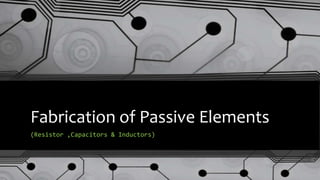
Fabrication of passive elements
- 1. Fabrication of Passive Elements (Resistor ,Capacitors & Inductors)
- 2. • Integrated Circuit • Resistors • Capacitors • Inductors • Uncertainty in IC Fabrication Content
- 3. Integrated Circuit An integrated circuit (IC) is a miniature ,low cost electronic circuit consisting of active and passive components fabricated together on a single crystal of silicon. The active components are transistors and diodes and passive components are resistors, inductors and capacitors.
- 4. Advantages of Integrated Circuit 1. Miniaturization and hence increased equipment density. 2. Cost reduction due to batch processing. 3. Increased system reliability due to the elimination of soldered joints. 4. Improved functional performance. 5. Matched devices. 6. Increased operating speeds. 7. Reduction in power consumption
- 5. Fabrication of Monolithic Integrated Circuit 1. Silicon wafer (substrate) preparation 2. Epitaxial growth 3. Oxidation 4. Photolithography 5. Diffusion 6. Ion implantation 7. Isolation technique 8. Metallization 9. Assembly processing & packaging
- 7. Introduction A resistor is a passive two-terminal electrical component that implements electrical resistance as a circuit element. The current through a resistor is in direct proportion to the voltage across the resistor's terminals. This relationship is represented by Ohm’s law (I=V/R) I is the current through the conductor in units of amperes, V is the potential difference measured across the conductor in units of volts, and R is the resistance of the conductor in units of ohms.
- 8. Resistance of Material Other conducting materials Ohm N+ polysilicon (t=500 nm) 20 Aluminum 0.07 Silicided Polysilicom 5 Silicided Source/drain diffusion 3 MOSIS 1 um CMOS PROCESS
- 9. IC Resistor Given the sheet resistance, we need to find the number of squares for this layout L / W = 9 squares
- 10. Laying Out a Resistor Rough approach: R known(Ns) = R / Rs(Sheet Resistance) Select a width W (possibly the minimum to save area) the length L = W N and make a rectangle L x W in area Add contact regions at the ends ... ignore their contribution to R
- 11. Layout of Resistor More careful approach: Account for the contact regions and also, for corners Measurement shows that the effective number of squares of the “dogbone” style contact region is 0.65 and for a angle 90 corner is 0.56. For the resistor with L / W = 9, the contact regions add a significant amount to the total square count: Ns= 9 + 2 (0.65) = 10.3
- 13. Introduction Capacitor is a basic storage device to store electrical charges and release it as it is required by the circuit. In a simple form it is made of two conductive plates (Electrodes) and an insulating media (Dielectrics) which separate the electrodes. The charges (Q) on the capacitor plates depend on the voltage (V)and the capacitance value (C) and is as follows: Q=C.V
- 14. Fabrication B+ n-Si SiO2 n-Si GROW 4000 A OXIDE ON N-TYPE SILICON MATERIAL PATTERN AND ETCH OXIDE<THEN ION IMPLANT 50 KeV BORON TO FROM P+ REGION
- 15. Thin SiO2 Al n-Si n-Si GROW THIN OXIDE (2000 A) PATTERN AND ETCH OXIDE TO FROM CONTACT DEPOSIT 5000A ALUMINUM PATTERN AND ETCH ALUMINUM Fabrication
- 16. Poly-Poly Capacitors Layout Substrate FOX Poly Poly2 Cross section tins Poly2 Area A2 Poly Top View Cp-Cp2=Eins/tin*A2
- 17. Metal-Metal Capacitors This type of structure is easily built in multiple-metal layer processes. The capacitors are formed using patterns on two metal layer. Cmm = Cxy *Aov Where Cxy is the capacitance per unit area and Aov is overlap area.
- 18. MOSFET Capacitors The gate implementation of capacitance of MOSFET also can be used to create a capacitor by shorting both the drain and source connections C=Eox/tox*Ag=CoxWL
- 20. Introduction An inductor (also choke, coil or reactor) is a passive two terminal electrical component that stores energy in its magnetic field. For comparison, a capacitor stores energy in an electric field, and a resistor does not store energy but rather dissipates energy as heat. Any conductor has inductance. An inductor is typically made of a wire or other conductor wound into a coil, to increase the magnetic field.
- 21. Construction of an inductor An inductor is usually constructed as a coil of conducting material, typically copper wire, wrapped around a core either of air or of ferromagnetic or ferrimagnetic material. Core materials with a higher permeability than that of air increase the magnetic field and confine it closely to the inductor, thereby increasing the inductance.
- 22. Silicon wafer Deposit 100nm of SiO2 Fabrication
- 23. Spin coat photo resist Mask exposure and develop the pattern Fabrication
- 24. Deposit aluminum and copper alternately Photo resist removal. Fabrication
- 25. Spiral Micro Inductor Spiral micro inductor.
- 26. Schematic layer Structure Microphotograph of the spiral inductor fabricated on the A1203 substrateSchematic layer structure of the spiral inductor fabricated on the A1203 substrate
- 27. The precision of transistors and passive components fabricated using IC technology is surprisingly, poor! Sources of variations: Ion impant dose varies from point to point over the wafer and from wafer to wafer. Thicknesses of layers after annealing vary due to temperature variations across the wafer. Widths of regions vary systematically due to imperfect wafer flatness (leading to focus problems) and randomly due to raggedness in the photoresist edges after development. Uncertainties in IC Fabrication
